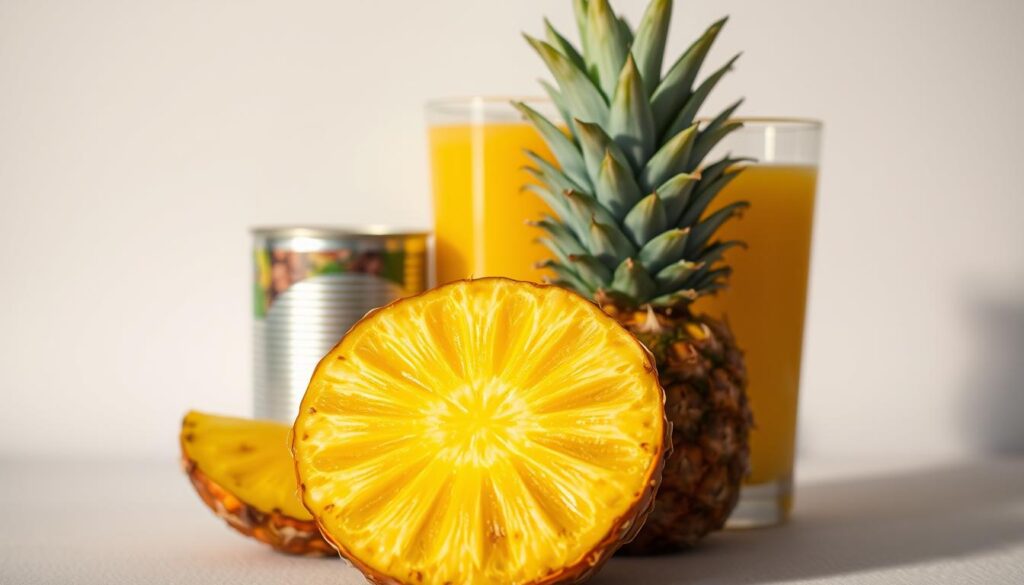Managing blood sugar levels requires careful food choices, especially when enjoying sweet fruits. This tropical favorite packs vitamins and antioxidants but also contains natural sugars that affect glucose. Understanding this balance helps you make informed decisions about including it in your diet.
The glycemic index (GI) measures how quickly foods raise sugar levels. While fresh pineapple has a moderate GI, its impact varies based on ripeness and portion size. The American Diabetes Association recommends pairing fruits with protein or healthy fats to slow sugar absorption.
Portion control is key. A small serving provides manganese and vitamin C without spiking blood sugar. Combining it with nuts or yogurt creates a balanced snack. This approach aligns with meal-planning strategies for people with diabetes.
This article breaks down pineapple’s nutritional profile, carbohydrate content, and practical ways to enjoy it safely. You’ll learn how to balance its benefits against potential risks while maintaining stable glucose levels.
Introduction
A diabetes-friendly meal plan prioritizes nutrient-rich foods while managing carbohydrate intake. The American Diabetes Association emphasizes balancing fruits with proteins and healthy fats to maintain stable blood glucose. This approach allows you to enjoy sweet options without compromising health goals.
Overview of Pineapple in a Diabetes Meal Plan
This tropical fruit delivers vitamin C, manganese, and antioxidants. However, its natural sugar content means portion control matters. Pairing a small serving with Greek yogurt or almonds slows digestion, reducing blood sugar spikes.
Understanding the Importance of Balanced Diets
Including fruits like pineapple adds variety and essential nutrients to meals. Focus on whole options over juices or canned varieties, which often contain added sugars. Fiber in fresh produce supports slower glucose absorption, aligning with ADA guidelines for balanced eating.
Regularly monitoring carb intake helps maintain energy levels and metabolic health. Compare different fruit forms to make informed choices—opt for fresh slices instead of syrup-packed versions. Small adjustments ensure you reap benefits without risking blood sugar imbalances.
Nutritional Profile of Pineapple
This vibrant fruit offers a mix of essential nutrients that can complement a balanced eating pattern. While its natural sweetness demands mindful consumption, its vitamin-rich composition provides valuable health perks when enjoyed strategically.
Essential Nutrients for Metabolic Support
One cup of fresh chunks delivers 79 mg of vitamin C—over 100% of daily needs—and 76% DV for manganese. These nutrients aid enzyme function and antioxidant defense. Bromelain, a unique enzyme in this fruit, may reduce inflammation linked to chronic conditions.
Fiber’s Role in Glucose Management
With 2.3 grams of fiber per serving, fresh options help slow sugar absorption. Compare this to canned varieties, which lose up to 50% of their fiber and often contain added sweeteners. Pairing fibrous foods with proteins creates meals that stabilize energy levels throughout the day.
Research shows antioxidants like quercetin in this tropical choice combat oxidative stress, benefiting those managing metabolic health. Opt for whole fruit over juices to maximize these advantages while keeping carb intake aligned with your diet goals.
Understanding Carbohydrates and the Glycemic Index
Carbohydrates directly influence blood sugar levels, making them a critical focus for metabolic health. When digested, carbs break down into glucose, which enters the bloodstream. Processed forms like juice lack fiber, causing faster sugar absorption compared to whole fruits.
How Carbohydrates Affect Blood Sugar Levels
Simple carbs, such as those in sweetened beverages, spike glucose rapidly. Whole fruits slow this process due to their fiber content. For example, one cup of fresh pineapple contains natural sugars paired with 2.3 grams of fiber—a balance that supports steadier energy release.
What the Glycemic Index Means for Diabetics
The glycemic index (GI) ranks foods by their glucose-raising potential. Pineapple’s GI score varies: fresh chunks have a moderate value, while juice scores higher due to reduced fiber. Pairing high-GI foods with proteins or fats can lower their overall impact.
Processing methods matter. Canned or juiced versions lose up to 50% of their vitamin C and fiber, accelerating sugar absorption. Choosing whole fruit helps maintain nutrient content while managing carb intake. Monitoring portions—like sticking to a half-cup serving—supports better health outcomes without sacrificing flavor.
Is pineapple good for diabetics
Balancing sweet cravings with blood sugar management often raises questions about fruit choices. Experts emphasize moderation and strategic pairing to maximize benefits while minimizing risks.

Exploring the Benefits
A ½-cup serving provides 15g carbohydrates alongside 78% of your daily vitamin C needs. This nutrient supports immune function and helps your body absorb iron. Manganese in each portion aids bone health and metabolism regulation.
Fresh options deliver bromelain—an enzyme shown to reduce inflammation. Pairing this food with protein-rich foods like cottage cheese creates a satisfying snack that stabilizes energy levels. Studies suggest its antioxidants may lower oxidative stress linked to chronic conditions.
Potential Risks and Considerations
Overconsumption can spike glucose due to natural sugars. Canned varieties in syrup add 10-15g extra sugar per serving compared to fresh chunks. Always check labels for added sweeteners when selecting packaged food.
Portion size directly impacts carbohydrate intake. The American Diabetes Association recommends limiting fruit servings to 15g carbs per meal. Combine with fiber-rich foods like chia seeds to slow digestion.
Consult your healthcare provider to determine how this source of nutrients fits your personalized plan. Individual responses vary, making professional guidance essential for safe dietary adjustments.
Portion Sizes and Serving Ideas for Blood Sugar Control
Smart portion management helps maintain steady energy while keeping glucose levels stable. The USDA recommends ½ cup of fresh chunks as one serving—containing 15g carbohydrates and 2.3g fiber. This balance makes it easier to fit into daily meal plans without spiking sugar.
Carb Counting and Meal Planning Strategies
Track your intake using apps or journals to stay within 15-30g carbohydrates per snack. Pair ½ cup of this tropical fruit with 10 almonds (3g protein) or ¼ cup cottage cheese. These combos slow digestion, delivering nutrients steadily.
Serving Size Recommendations
Measure portions carefully—a heaping ½ cup equals about 82 grams. Avoid canned varieties packed in syrup, which add 12g extra sugar per serving. Instead, freeze fresh chunks for a cool treat that preserves minerals like manganese.
Incorporate this fruit as part of salads or grilled dishes. Try mixing it with spinach (rich in magnesium) or chia seeds (high in fiber). These pairings enhance nutrient absorption while supporting metabolic health. Always test glucose levels after meals to gauge personal tolerance.
Comparing Pineapple Forms: Fresh, Canned, and Juiced
Not all pineapple products offer the same nutritional value. Processing methods dramatically alter vitamin content, fiber levels, and sugar absorption rates. Understanding these differences helps you maximize health benefits while managing glucose.

Impact of Processing on Nutrient Content
Fresh chunks retain 100% of their natural vitamins and antioxidants. Studies show canned versions lose 50% of vitamin C during heat treatment. Juicing removes nearly all fiber, accelerating how quickly sugars enter your bloodstream.
Syrup-packed cans add 10-15g of sugar per serving compared to fresh fruit. This added sweetness can raise blood sugar faster than natural fructose. Choose juice labeled “no added sugar” to avoid hidden sweeteners.
Choosing the Best Option for Your Diet
Fresh or frozen pineapple preserves fiber best—2.3g per ½ cup. This slows digestion, preventing sudden glucose spikes. Canned options in water (not syrup) offer convenience with fewer health benefits than raw fruit.
For smoothies, blend fresh chunks with spinach and chia seeds. This combo balances natural sugars with protein and fats. Always check labels: phrases like “in heavy syrup” signal added sweeteners that may raise blood sugar levels unnecessarily.
Prioritize whole fruit to get the full spectrum of vitamins and antioxidants. When fresh isn’t available, unsweetened frozen varieties provide similar benefits without compromising your dietary goals.
Incorporating Pineapple into a Diabetes-Friendly Diet
Strategic meal planning lets you enjoy tropical flavors while keeping blood glucose levels stable. Focus on balancing natural sweetness with slow-digesting nutrients to prevent sudden spikes. This approach aligns with ADA guidelines for maintaining energy and metabolic health.
Smart Pairing for Balanced Nutrition
Combine fresh chunks with protein sources like Greek yogurt or cottage cheese. These pairings slow sugar absorption, reducing the risk of raise blood sugar fluctuations. A ½-cup serving with 1 oz almonds creates a snack under 20g carbohydrate.
Avoid canned varieties packed in heavy syrup—opt for water-packed versions instead. Drain and rinse them to remove excess sweetness. Frozen chunks work well in smoothies blended with spinach and chia seeds for added fiber.
Follow this 3-step plan for meals:
1. Measure portions to stay within 15g carbohydrate per serving
2. Add lean protein like grilled chicken or tofu
3. Include healthy fats like avocado to further stabilize blood glucose levels
Try pineapple salsa with fish tacos or add diced pieces to quinoa salads. These meals deliver flavor without compromising your plan. Always monitor blood glucose levels after trying new combinations to understand personal responses.
Conclusion
Balancing flavor and health goals is achievable with mindful choices. This tropical fruit offers vitamins and antioxidants, but natural sugars require careful portion control. Pairing small servings with proteins like nuts or yogurt aligns with American Diabetes Association guidelines to stabilize blood glucose levels.
Choose fresh or frozen options over canned varieties in syrup to avoid added sugars. Always check labels for hidden sweeteners that may spike blood glucose. Regular monitoring after meals helps identify personal tolerance levels.
The American Diabetes Association emphasizes consulting healthcare providers to tailor dietary plans. When enjoyed in moderation and combined with balanced meals, this sweet addition can fit safely into your routine. Explore personalized strategies to maintain optimal blood glucose control while savoring diverse flavors.
FAQ
Can people with diabetes safely eat pineapple?
Yes, when consumed in moderation. Fresh pineapple has a moderate glycemic index (GI) of 66, so pairing it with protein or healthy fats can help stabilize blood glucose levels. Always consult your healthcare provider to determine appropriate portions for your meal plan.
How does pineapple affect blood sugar compared to other fruits?
Its glycemic impact is higher than berries or apples but lower than tropical fruits like mango. A ¾-cup serving contains about 15g of carbohydrates, so carb counting is essential. Fiber and antioxidants in fresh pineapple may also slow sugar absorption.
What’s the healthiest way to include pineapple in a diabetic diet?
Opt for fresh or frozen chunks over canned varieties with added syrup. Combine a small portion (½ cup) with Greek yogurt or nuts to balance the meal. Avoid juices, which lack fiber and concentrate natural sugars.
Does pineapple provide nutrients that benefit those managing diabetes?
Absolutely. It’s rich in vitamin C, manganese, and bromelain—an enzyme linked to reduced inflammation. The fiber content (2.3g per cup) supports digestion and may improve glycemic control when eaten as part of a balanced diet.
Are there risks to eating pineapple if you have insulin resistance?
Overconsumption can spike blood glucose due to its natural sugars. Canned versions in heavy syrup or sweetened dried fruit should be avoided. Monitor your body’s response and adjust servings based on your glucose meter readings.
What’s the American Diabetes Association’s stance on pineapple?
The ADA classifies it as a “medium GI” fruit and recommends mindful portion sizes. They emphasize pairing it with low-carb foods like cottage cheese or leafy greens to minimize blood sugar fluctuations.
Can pineapple juice fit into a diabetes-friendly eating plan?
Juice lacks the fiber found in whole fruit, leading to faster sugar absorption. If consumed, limit to 4 ounces and choose 100% unsweetened varieties. Better alternatives include water-infused with pineapple chunks for flavor without the carbs.


